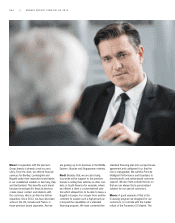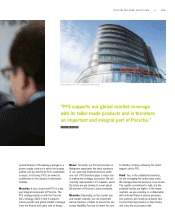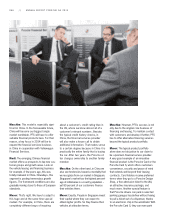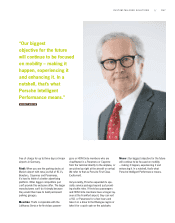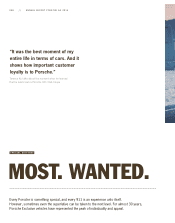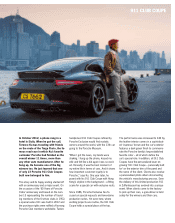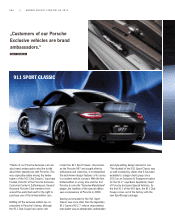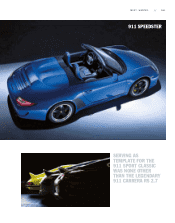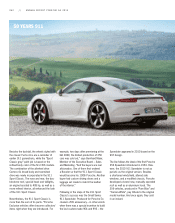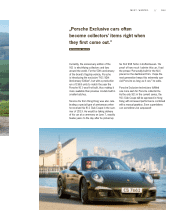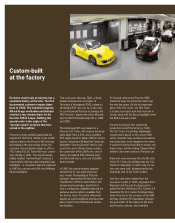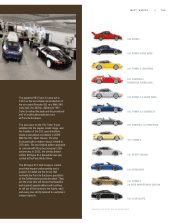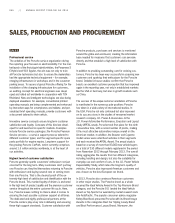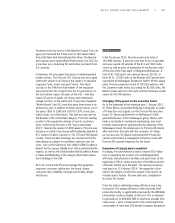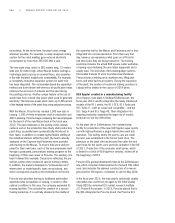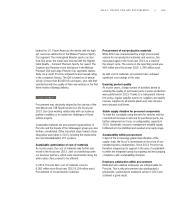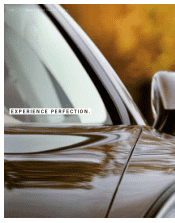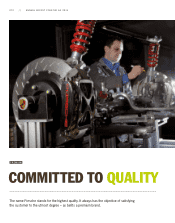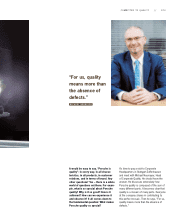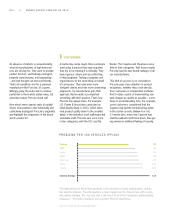Porsche 2013 Annual Report Download - page 66
Download and view the complete annual report
Please find page 66 of the 2013 Porsche annual report below. You can navigate through the pages in the report by either clicking on the pages listed below, or by using the keyword search tool below to find specific information within the annual report.
064 // ANNUAL REPORT PORSCHE AG 2013
Exclusive small-scale production has a
venerable history at Porsche. The rst
documented customer request dates
back to 1962. The industrial magnate
Alfried Krupp von Bohlen und Halbach
ordered a rear window wiper for his
Porsche 356 B Coupé. Fullling this
special order is the origin of the
“special request” program that blos-
somed in the eighties.
Porsche’s racing activities generated the
impetus for this trend. Similar to the modifi-
cations made to the Porsche 935 that was
dominating in the auto racing circuit, the
customer service division began to offer a
‘911 Turbo/911 SC Turbo flat nose’ conver-
sion starting in 1981. The special design,
initially dubbed “hammerhead”, features a
characteristic flat nose with integrated dual
headlights – a conversion that was replaced
in 1983 by a version with 924- and 944-type
flip-up headlights.
That same year, Mansour Ojjeh, a Saudi
Arabian businessman and owner of
Technique d´Avantgarde (TAG), ordered a
street-legal 935 race car. As a side note,
he commissioned Porsche to develop the
TAG Formula 1 engine with which McLaren
won the World Championship title in 1984
and 1985.
The street-legal 935 was based on a
Porsche 911 Turbo, with chassis and body
parts taken from a 935, and a modified
934 engine tuned to deliver 409 hp. Includ-
ing the customized “Brilliant Red” paint job,
full-leather “Creme Caramel” interior, burl
wood trim, and a Clarion stereo system,
the conversion of the 285-km/hr, one-of-
a-kind car required 550 individual parts
and 300 work hours, and cost 350,000
deutschmarks.
In 1986, the special request program
evolved into its own pioneering busi-
ness model. The founding of ‘Porsche
Exclusive’ represented the first time a car
manufacturer offered customization and
enhancement packages. And the first
time a catalog was available featuring the
exclusive special options available from
the factory. Soon, Porsche’s refinement
experts procured additional premises that
were closer to the Zuffenhausen produc-
tion facilities.
Custom-built
at the factory
911-based, slant-nosed Porsche 948s
started to leave the production plant over
the next few years. As the last represent-
ative of the 911 series, the 964 Turbo
3.6 slant nose had a look that was born in
racing, along with the flip-up headlights from
the 968 trans-axle model.
Porsche Exclusive’s first small-scale
production run left the factory in 1992.
The 911 Turbo S Leichtbau (lightweight
construction), based on the current 964
series, featured many exclusive innovations
that would later on be adopted in the series.
It was the first time that 18-inch wheels, red
brake shoes, and the striking “Speed Yellow”
exterior color were used on a Porsche car.
Rarer and more exclusive than the 86 units
of the 911 Turbo S Leichtbau was the 911
Carrera 2 Speedster, of which only 15 cus-
tom units were built, distinguished by the
wide-body look of the Turbo models.
Only two cars were created from the
successor model. In 1995, engineers from
Weissach and Porsche Exclusive put to-
gether the first 993-based 911 Carrera 3.6
Speedster for 911 creator Ferdinand Alex-
ander Porsche on the occasion of his 60th
birthday. Another 993 Speedster followed
five years later at the request of US actor
and Porsche collector Jerry Seinfeld.


